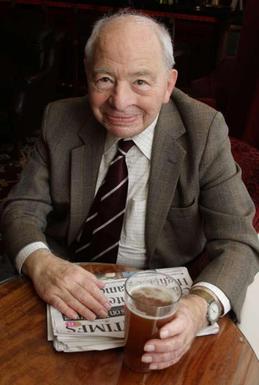
Norman Colin Dexter was an English crime writer known for his Inspector Morse series of novels, which were written between 1975 and 1999 and adapted as an ITV television series, Inspector Morse, from 1987 to 2000. His characters have spawned a sequel series, Lewis, from 2006 to 2015, and a prequel series, Endeavour, from 2012 to 2023.

A crossword is a word game consisting of a grid of black and white squares, into which solvers enter words or phrases ("entries") crossing each other horizontally ("across") and vertically ("down") according to a set of clues. Each white square is typically filled with one letter, while the black squares are used to separate entries. The first white square in each entry is typically numbered to correspond to its clue.

A cryptic crossword is a crossword puzzle in which each clue is a word puzzle. Cryptic crosswords are particularly popular in the United Kingdom, where they originated, as well as Ireland, the Netherlands, and in several Commonwealth nations, including Australia, Canada, India, Kenya, Malta, New Zealand, and South Africa. Compilers of cryptic crosswords are commonly called setters in the UK and constructors in the US. Particularly in the UK, a distinction may be made between cryptics and quick crosswords, and sometimes two sets of clues are given for a single puzzle grid.

Reeson Wayne Shearsmith is an English actor, comedian, writer and magician. He was a member of The League of Gentlemen, with Steve Pemberton, Mark Gatiss and Jeremy Dyson. Jointly with Pemberton, created, wrote, and starred in the sitcom Psychoville and the dark comedy anthology series Inside No. 9. He had notable roles in Spaced and The World's End.

Steven James Pemberton is a British actor, comedian, director and writer. He was a writer and actor for BBC's The League of Gentlemen with Reece Shearsmith, Mark Gatiss, and Jeremy Dyson. Pemberton and Shearsmith also co-wrote and starred in the black comedy Psychoville and the anthology series Inside No. 9. His other notable television performance credits include Doctor Who, Benidorm, Blackpool, Shameless, Whitechapel, Happy Valley and Mapp & Lucia.

Roger Squires was a British crossword compiler/setter, who lived in Ironbridge, Shropshire. He was best known for being the world's most prolific compiler. He compiled under the pseudonym Rufus in The Guardian, Dante in The Financial Times and was the Monday setter for the Daily Telegraph.

Inside No. 9 is a British black comedy anthology television programme written and created by Steve Pemberton and Reece Shearsmith. It aired on BBC Two from 5 February 2014 to 12 June 2024, running for 9 series and 55 episodes. Each 30-minute episode is a self-contained story with new characters and a new setting, almost all starring Pemberton or Shearsmith. Aside from the writers, each episode has a new cast, allowing Inside No. 9 to attract a number of well-known actors. The stories are linked only by a setting related to the number 9 in some way, and a brass hare statue that is hidden in all episodes. Themes and tone vary from episode to episode, but all have elements of comedy and horror or perverse humour, in addition to a plot twist.

"Sardines" is the first episode of the first series of the British black comedy anthology series Inside No. 9. Written by Steve Pemberton and Reece Shearsmith, it premiered on BBC Two and BBC Two HD on 5 February 2014. In the episode, a group of adults play sardines at an engagement party. Rebecca, the bride-to-be, finds a boring man named Ian in a wardrobe; he introduces himself as a colleague of Jeremy, Rebecca's fiancé. The pair are subsequently joined by family, friends and colleagues of Rebecca and Jeremy. As more people enter the room and step into the wardrobe, secrets shared by some of the characters are revealed, with various allusions to incestuous relationships, child sexual abuse, and adultery. The humour is both dark and British, with references to past unhappiness and polite but awkward interactions.

"A Quiet Night In" is the second episode of the British dark comedy television anthology series Inside No. 9. It first aired on 12 February 2014 on BBC Two. Written by Reece Shearsmith and Steve Pemberton, it stars the writers as a pair of hapless burglars attempting to break into the large, modernist house of a couple—played by Denis Lawson and Oona Chaplin—to steal a painting. Once the burglars make it into the house, they encounter obstacle after obstacle, while the lovers, unaware of the burglars' presence, argue. The episode progresses almost entirely without dialogue, relying instead on physical comedy and slapstick, though more sinister elements are present in the plot. In addition to Pemberton, Shearsmith, Lawson and Chaplin, "A Quiet Night In" also starred Joyce Veheary and Kayvan Novak.

"Tom & Gerri" is the third episode of British dark comedy anthology series Inside No. 9. It premiered on BBC2 on 19 February 2014. The episode was based on a play that Steve Pemberton and Reece Shearsmith had written while living together prior to the development of their series The League of Gentlemen. While the play had originally been around two hours in length, the episode was only half an hour. "Tom & Gerri" follows a difficult period in the life of Tom (Shearsmith), a primary school teacher and aspiring writer, and his girlfriend Gerri, a struggling actress, after Tom invites the homeless Migg (Pemberton) into his home. Conleth Hill stars as Stevie, a man worried about the mental health of his friend Tom. The entire episode takes place inside Tom's flat.

"Last Gasp" is the fourth episode of the first series of the British dark comedy anthology television programme Inside No. 9. It first aired on 26 February 2014 on BBC Two. The story revolves around the ninth birthday of the severely ill Tamsin. Tamsin's parents Jan and Graham have arranged with the charity WishmakerUK for the singer Frankie J Parsons to visit as a treat for their daughter. Frankie dies after blowing up a balloon, leading to arguments between Graham, the WishmakerUK representative Sally, and Frankie's assistant Si over the now-valuable balloon containing Frankie's last breath. The story, written by Pemberton and Reece Shearsmith, was inspired by someone Pemberton had seen on Swap Shop who collected air from different places.
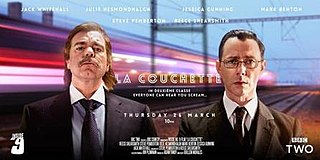
"La Couchette" is the first episode of the second series of British dark comedy anthology Inside No. 9. Written by Steve Pemberton and Reece Shearsmith and directed by Guillem Morales, the episode is set in a sleeper carriage on a French train. English doctor Maxwell, who is traveling to an important job interview, climbs into bed. He is disturbed first by drunk, flatulent German Jorg, and then by English couple Kath and Les. Later, while the others sleep, Australian backpacker Shona brings posh English backpacker Hugo back to the cabin, but the pair make a surprising discovery. The episode stars Pemberton, Shearsmith, Julie Hesmondhalgh, Mark Benton, Jessica Gunning, Jack Whitehall and George Glaves.
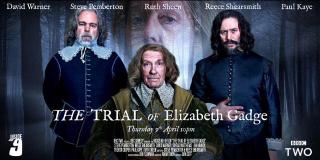
"The Trial of Elizabeth Gadge" is the third episode of the second series of the British dark comedy anthology television programme Inside No. 9. It was written by Reece Shearsmith and Steve Pemberton, and directed by Dan Zeff. It first aired on 9 April 2015 on BBC Two. The story follows a 17th-century witch trial. Elizabeth Gadge, played by Ruth Sheen, stands accused of witchcraft by inhabitants of the village of Little Happens, including characters played by Sinead Matthews, Jim Howick, Paul Kaye and Trevor Cooper. The magistrate Sir Andrew Pike, played by David Warner, has summoned the famed witch-finders Mr Warren and Mr Clarke, played by Shearsmith and Pemberton, to try Elizabeth, but is more concerned with bringing visitors to the village than finding the truth.
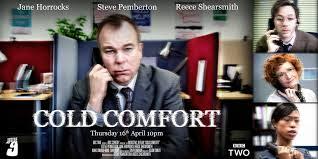
"Cold Comfort" is the fourth episode of the second series of the British dark comedy anthology television programme Inside No. 9. The episode, which was written and directed by Steve Pemberton and Reece Shearsmith, was first broadcast on 16 April 2015 on BBC Two. Most of "Cold Comfort" is composed of a stream from a fixed camera on the desk of Andy, the protagonist, with smaller pictures on the side of the screen, in the style of a CCTV feed. "Cold Comfort" was filmed over two and a half days in Twickenham, and was, like "A Quiet Night In" from Inside No. 9's first series, highly experimental. It was Pemberton and Shearsmith's directorial debut.
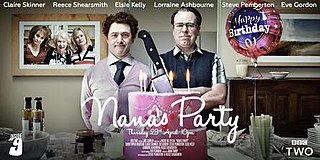
"Nana's Party" is the fifth episode of the second series of the British dark comedy anthology television programme Inside No. 9. It was first broadcast on 23 April 2015 on BBC Two. Written and directed by Steve Pemberton and Reece Shearsmith, the episode starred Claire Skinner as the obsessive-compulsive and aspirational Angela, who is hosting a party for the 79th birthday of her mother Maggie, played by Elsie Kelly. Angela's husband Jim, played by Pemberton, is keen to play a prank on Pat, Angela's brother-in-law, who is a practical joker. Pat is played by Shearsmith, while Carol, a recovering alcoholic who is Pat's wife and Angela's sister, is played by Lorraine Ashbourne. The episode also features Eve Gordon as Katie, Angela and Jim's teenage daughter, and Christopher Whitlow as a paramedic seen at the beginning and end of the episode.
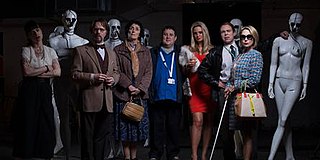
"Private View" is the sixth and final episode of the third series of the British black comedy anthology television programme Inside No. 9. Written by Steve Pemberton and Reece Shearsmith, the episode was directed by Guillem Morales and was first shown on 21 March 2017, on BBC Two. It stars Pemberton, Shearsmith, Fiona Shaw, Montserrat Lombard, Morgana Robinson, Felicity Kendal, Johnny Flynn, and Muriel Gray. The comedian Peter Kay makes a cameo appearance, with his character being killed in the episode's opening seconds.
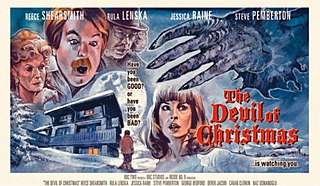
"The Devil of Christmas" is a Christmas special of the British dark comedy anthology television programme Inside No. 9, and the first episode of the third series. It was first aired on 27 December 2016 on BBC Two. The episode was directed by Graeme Harper and written by Reece Shearsmith and Steve Pemberton. Stylistically, it took heavy inspiration from classic 1970s anthology programmes, such as Beasts, Thriller, Tales of the Unexpected and Armchair Thriller, and was filmed using authentic equipment. Pemberton intended the episode to be a recreation of this kind of classic programming, with critics characterising it as a homage, pastiche or loving parody.

"The Bill" is the second episode of the third series of the British dark comedy anthology television programme Inside No. 9. It first aired on 21 February 2017, on BBC Two. The episode was written by Reece Shearsmith and Steve Pemberton, and was directed by Guillem Morales. "The Bill" focuses on four men—Archie, Malcolm, Kevin, and Craig—arguing over who should pay the bill in a restaurant at closing time, much to the dismay of the waitress Anya. It addresses themes of masculinity and competition, and the English north–south divide is a recurring issue; Craig, the visiting southerner, is wealthier than the other three, and unfamiliar with some of their terminology.

"Empty Orchestra" is the fourth episode of the third series of the British dark comedy anthology television programme Inside No. 9. Written by Steve Pemberton and Reece Shearsmith and directed by Guillem Morales, the episode was first shown on 7 March 2017, on BBC Two. "Empty Orchestra" is set in a karaoke booth, and follows a group of colleagues—Greg (Shearsmith), Fran, Connie, Janet and Duane —celebrating the promotion of Roger (Pemberton). Rebekah Hinds also features.

"Diddle Diddle Dumpling" is the fifth episode of the third series of the British black comedy anthology television series Inside No. 9. It was written by Steve Pemberton and Reece Shearsmith, and first aired on 14 March 2017, on BBC Two. The episode, which was directed by Guillem Morales, follows the story of David, played by Shearsmith, a middle class stay-at-home dad, who happens across a lone black shoe. Much to the concern of his wife Louise, played by Keeley Hawes, he becomes obsessed with finding the shoe's owner. The episode follows the development of his obsession. Rosa Strudwick plays Sally, David and Louise's daughter, and Pemberton plays Chris, a family friend. Danny Baker voices a radio presenter, and Mathew Baynton also appears.
























